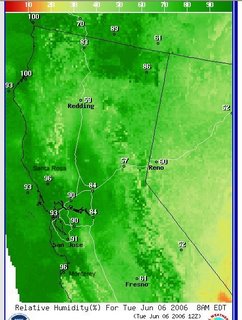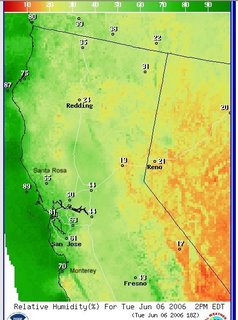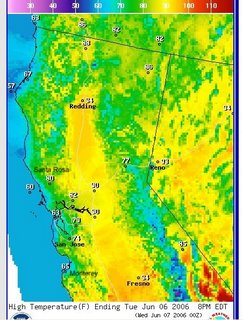Some interesting news from last week, but not really unexpected from a viticultural perspective:Global Warming Hurts Spain's Vineyards, Forces Vintners to MoveWinemakers from Europe's largest grape-growing nation are shading vineyards, developing heat-resistance crops and moving to mountainside locations. Temperatures may rise 7 degrees Celsius by the end of the century, said Jose Manuel Moreno, professor of climatology at the University of Castilla La Mancha. …
Miguel Torres SA, based near Barcelona, is buying fields in the peaks of northeastern Spain, where the weather is cooler, said Sort. Castell d'Encus vintner Raul Bobet has picked a spot 1,000 meters (3,281 feet) high in the Pyrenees for his label. …
Heat and sunlight increase sugar levels in wine grapes, which can boost alcohol content beyond what is palatable. Hotter weather may also curb grape acidity, changing the flavor, and unexpectedly rainy and cold seasons can devastate a year's crop.
In Malaga and Cadiz, the most southern wine-growing regions, temperatures can top 40 degrees during the summer months. Spain is the closest major European wine producer to the equator, making it particularly vulnerable to climate changes.
``Climate change is the biggest environmental challenge modern society faces,'' said Jose Ramon Picatoste, an official in Spain's Environmental Ministry, at a conference in Barcelona in March. ``Industries will need to adapt.''
One degree of climate changes makes wine-growing regions in the Northern Hemisphere similar to regions 200 kilometers further south, said Bernard Seguin, a scientist at France's National Institute for Agronomic Research.
Their move is based on what's called the Environmental Lapse Rate, the variation or change of temperature with a rise in altitude in a relatively stationary atmosphere. The lapse rate at a given place varies slightly day by day, but is generally defined as a teperature decrease of 6.5 °C per km (3.6 °F/1000 ft) from sea level to ~11 km. So the move will just about offset the expected rise in temps over the next century. Latitudes formerly known for their quality wine will be abandoned, and become better known for more tropical agricultural products. Latitudes toward the poles will then become the new wine growing regions [Hmmm...Klondike Chard, Patagonian Pinot?].
Let's examine this dilemma for a moment. Say the following diagram shows common Cab Sauv descriptors based on the environment as it stands right now, progressing from green & under-ripe to burnt & over-ripe (click any pic to enlarge):
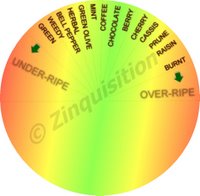
Where we are right now might be represented like this...
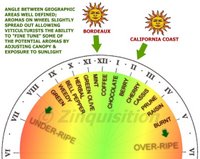
Climate and viticultural decisions (sun exposure, canopy management and temperature) would dictate where a region would be above the ring. In fact the ring could be viewed as an indicator of how much sunlight was hitting the vines in a certain area. That way, though I've placed Bordeaux and California's coast above the ring as generalities, they could be shifted either direction due to vintage variation and viticulture.
But imagine what the changes in the environment will bring about for winemaking. Increased sunlight in some areas previously known for foggy/cloudy weather will change all those flavor precursors available, as well as tannins. And therefore more fruit protection will be required to keep the fruit from the flavors & aromas at the "over-ripe" end of the spectrum. Denser canopy management like that in Australia will become more of the “norm” to help keep the fruit from getting too sunburnt...
This new warmer environment would modify the cab flavor wheel...
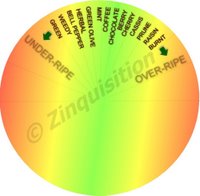
Note how the descriptors are compressed into a smaller angle on the wheel. Imagine also that this wheel can rotate to the left or right...to reflect warmer or cooler temperatures and viticultural decisions as mentioned above. In the warmer scenario you would see both the compression of descriptors and a rotation to the left, and possibly shifting of the traditional areas into the riper zones.
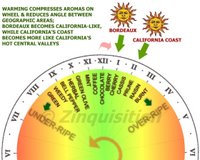
Scary...but what will the real impacts be?
Will Bordeaux shift to California-style descriptors? Will California shift to Texas descriptors? Will Judy leave Mark and start living with the twice-divorced and penniless but handsome Gary?...uhhm...sorry...scratch that last part...
It's all speculation what actually will happen, but I feel pretty safe in saying that there will be a shift towards wine growing in the coastal regions at higher latitudes where the sun's rays will be less intense, and where the maritime influence might still moderate the temps. It might be helpful to hedge the bet by going to a higher altitude in addition to that ...
Then again, coastal areas may not see temps rise as fast as inland areas, but they may become more humid and wetter during the summer months, which might lead to more mold issues with V. vinifera grapes. Hmmmm...
Oooohhh-kay, "Plan B" will be inland a bit more with at least one mountain range between us & the coast (to sap some of the moisture through rainfall formation), but definitely higher altitude, and more extreme latitude...
But is the Spanish move to higher ground a tacit acknowledgment that soil is only of a secondary or tertiary importance in “terroir”? Obviously it’s an admission that weather and clime are supreme in their terroir equation, otherwise they wouldn’t dare move, right?***Still don't believe in global warming?Check out the Union of Concerned Scientists website [link] which puts it into a sobering perspective (Migrating Climates: scariest of all is Illinois, which has winters more like Oklahoma & summers like East Texas by 2095!)... Labels: terroir

